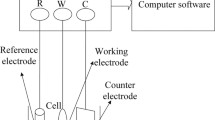Abstract
Molybdenum is an important modern industrial material. It is widely used in high-energy and high-heat environments due to its high melting point and thermal conductivity, as well as its low thermal expansion coefficient. Hole arrays on molybdenum sheets are commonly used in industry, with applications in ion plating equipment, projection electron microscopes, cryo-electron microscopy, and electron guns. However, fabrication of these arrays on molybdenum sheets is very difficult due to high opening ratio limitations, deformation of thin sheets, and the mechanical properties of the metal. Therefore, high-efficiency, high-precision fabrication of hole arrays on molybdenum sheets has emerged as a focus of research. Through-mask electrochemical machining (TMECM) is an effective method of fabricating hole-type components. This paper describes a method of fabricating hole arrays on a sheet using a TMECM process in a neutral NaNO3 solution. Polarization and current efficiency curves were measured for molybdenum in a NaNO3 solution to identify its electrochemical characteristics in the electrolyte. The results show that molybdenum dissolves well in NaNO3 solutions and exhibits good surface erosion uniformity. Furthermore, it does not produce obvious protuberances, dimples, or stress cracks. The experimental results indicate that hole arrays can be fabricated on molybdenum sheets with relatively high precision via a TMECM process with appropriate processing parameters. The aperture deviation was less than 0.05 mm, and the roundness deviation of the holes was less than 9.8 μm.
Similar content being viewed by others
References
Lasheen TA, El-Ahmady ME, Hassib HB, Helal AS (2015) Molybdenum metallurgy review: hydrometallurgical routes to recovery of molybdenum from ores and mineral raw materials. J Appl Stat 36:145–173
Hu J, Zhang Y, Chen S, He S, Li N, Chen J (2012) Inductively coupled plasma etching of bulk molybdenum. Proceedings of the IEEE International Conference on Micro Electro Mechanical Systems (MEMS) 59:267–270
Allen P, Chen X (2007) Process simulation of micro electro-discharge machining on molybdenum. J Mater Process Tech 186:346–355
Torres R, Kaempfe T, Delaigue M (2013) Influence of laser beam polarization on laser micro-machining of molybdenum. J Laser Micro Nanoen 8:188–191
Chen L (2011) Research the molybdenum alloy micro EDM micro-holes. Adv Mater Res 411:315–318
Sortino M, Totis G, Prosperi F (2013) Dry turning of sintered molybdenum. J. Mater. Process. Tech. 213:1179–1190
Mount AR, Eley KL, Clifton D (2000) Theoretical analysis of chronoamperometric transients in electrochemical machining and characterization of titanium 6/4 and inconel 718 alloys. J Appl Electrochem 30:447–455
Qu NS, Fang XL, Zhang YD, Zhu D (2013) Enhancement of surface roughness in electrochemical machining of Ti-6Al-4V by pulsating electrolyte. Int J Adv Manuf Tech 69:2703–2709
Gad-Allah AG, El-Rahman HAA, Abou-Romia MM (1988) A kinetic study on the corrodability of anodic oxide films formed on molybdenum in NaOH solutions. J Appl Electrochem 18:86–91
Abbas Q, Binder L (2011) The electrochemical dissolution of molybdenum in non-aqueous media. INT J Refract Met H 29:542–546
Itagaki M, Suzuki T, Watanabe K (1997) Channel flow double electrode study on anodic dissolution of molybdenum in sulfuric acid solution. Electrochim Acta 42:1081–1086
Badawy WA, Gad-Allah AG, El-Rahman HAA, Abou-Romia MM (1987) On the stability of anodic oxide films formed on molybdenum in various aqueous solutions. Surf Coat Tech 30:365–373
Itagaki M, Suzuki T, Watanabe K (1996) Influence of halide ions on transpassive dissolution of Mo in neutral aqueous solution. Electrochem 64:311–313
Silva AKMD, Altena HSJ, Mcgeough JA (2003) Influence of electrolyte concentration on copying accuracy of precision-ECM. CIRP Annals – Manuf Technol 52:165–168
Jelliti S, Richard C, Retraint D (2013) Effect of surface nanocrystallization on the corrosion behavior of Ti–6Al–4V titanium alloy. Surf. Coat. Tech. 224:82–87
Spieser A, Ivanov A (2013) Recent developments and research challenges in electrochemical micromachining (μECM). Int. J. Adv. Manuf. Tech. 69:563–581
Wang DY, Zhu ZW, Wang NF (2015) Investigation of the electrochemical dissolution behavior of Inconel 718 and 304 stainless steel at low current density in NaNO3 solution. Electrochim Acta 156:301–307
Schubert N, Schneider M, Michealis A (2013) The mechanism of anodic dissolution of cobalt in neutral and alkaline electrolyte at high current density. Electrochim Acta 113:748–754
Author information
Authors and Affiliations
Corresponding author
Rights and permissions
About this article
Cite this article
Li, H.S., Wang, G.Q., Li, L.W. et al. Through-mask electrochemical machining of hole arrays on molybdenum sheets. Int J Adv Manuf Technol 93, 2393–2401 (2017). https://doi.org/10.1007/s00170-017-0686-2
Received:
Accepted:
Published:
Issue Date:
DOI: https://doi.org/10.1007/s00170-017-0686-2




